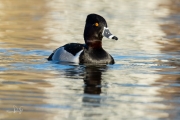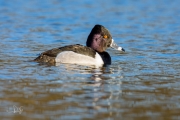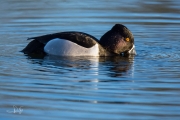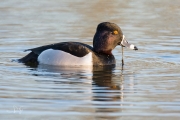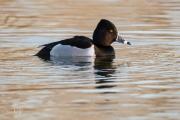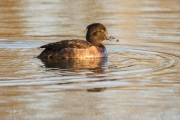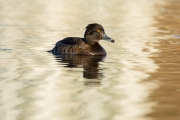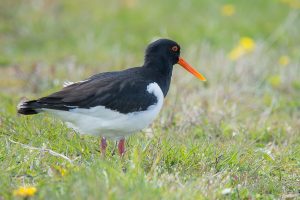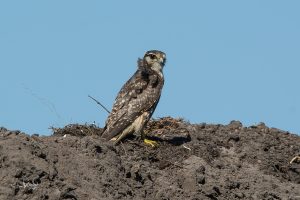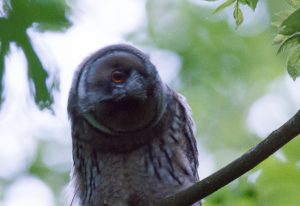In the first weeks of 2017 we were under the spell of a mad American. One that kept the fascination of many people and had many eyes and cameras focused on him. He came out of nowhere and immediately felt at home. Not in a special place, but close to that white building. He was often found in the company of European compagnions and it seemed that he had his eyes set on one particular European female. The other females were very impressed by this macho behavior.
No orange hair
No, he didn’t have orange hair and didn’t use Twitter. But on the other hand he could gaggle like the best. On February 11th 2017, he suddenly appeared in a small pond in Appingedam, a little town in the north of the Netherlands. The first person who observed him wasn’t very certain and posted a photo to the internet. And soon he got confirmation that it was indeed a very rare ring-necked duck (Aythya collaris), because that’s what I’m talking about. It is very similar to the tufted duck (Aythya fuligula), but without a crest. That is one of the most important differences, besides the striking white ring around the bill and the white bill base. That’s where the bird’s Dutch name is derived from: ‘ringsnaveleend’, translated ring-billed duck in English. The male also has a faint narrow chestnut ring encircling the neck, so that’s the origin of its English name. Just like the tufted duck it’s a member of the diving duck subfamily Aythyinae. They dive under water in search for their food (plants).
Twitchers
Our own crazy American didn’t have to complain about a lack of attention. Almost every day it would swim around in the puddle for everyone to see. This led to a large number of recordings and photos being submitted to wildlife websites and Facebook. On some days there would be a proper gathering of people and birdwatchers and photographers would be stumbling over each other to catch a glimpse of this bird. Now I am not the kind of person who runs out for scoops and drives of to every reported location of a rare bird (they call that twitching in birders terms). But this time a rare bird showed up at about 12 kilometers from where I live, so that was really nearby. So on one afternoon I went over there and found myself a nice spot in the last sunbeams of the day. The sunlight spread a beautiful golden glow over the water and I could take some pictures of the duck during the so-called golden hour.
Hybrid ducklings
That afternoon the ring-necked duck was accompanied by his girlfriend, a female tufted duck and they seemed to have a good time together. I also took some pictures of her. Our beloved ring-neck was even putting on a courtship display for her. After all, it would not be the first time that a ring-necked duck and tufted duck would form a pair with hybrid ducklings as a result. Who knows, after all it is family of each other. The ring-necked duck is also called American tufted duck, especially by bird keepers who keep the animal in, often covered, ponds. These animals in captivity must have a tag around their leg. This particular ring-necked duck had no ring, so it was almost certainly a wild bird. Since it, as its nickname suggests, normally lives in North America, it had made a good long flight over the water to get here. Perhaps he was driven here by storms or hurricanes and lost his way. However we cannot be entirely sure what its/his origin is as some bird keepers don’t follow the rules regarding tags.
Scandinavia and back?
The duck seemed to have a good time and was not yet ready to go back to the other side of the ocean. But after a few months at the beginning of April it disappeared. Had he flown back to North America or did he find another spot in the Netherlands to hang out at? It wasn’t seen in our country anymore, until about nine months later on January 7th 2018. Suddenly it was back again at its usual spot. And once again it was flirting with a female tufted duck. Just like the year before in the beginning of April the duck disappeared. So where has this bird been in the mean time? Back to its roots in the States? That seems almost impossible and hard to believe that it flew back to the Netherlands twice. And now, on January 3rd 2019, it showed up again in Appingedam. In the same pond at the same place. This can’t be coincidence and it seems most logical that the bird hasn’t left the European continent in the last years. But that it was possibly somewhere in Scandinavia during the summer. Perhaps with its tufted girlfriend and maybe some hybrid descendants.
This post was originally published in Dutch on February 26nd 2017



